1. Introduction
Double-clad erbium-doped fiber lasers play a basis role in multiple fields due to their outstanding performance. As the core light source for 5G/6G communication, it can substantially enhance the quality of signal transmission. In the industrial field, its high-power characteristics provide reliable tools for precise welding and micro-processing. In the field of medicine, it is widely applied to minimally invasive surgeries such as those in ophthalmology and dermatology. Meanwhile, these lasers have significant values in fields such as laser radar and optical fiber sensing for national defense and infrastructure monitoring and provide technical support for cutting-edge research such as quantum communication. With the continuous increase in application demands, in-depth research on its power transmission characteristics and optimization of doping concentration is of great importance for promoting the development of related fields.
In recent years, significant progress has been made in the research of erbium-doped fiber lasers. Guan et al. proposed and applied the cascaded energy transfer pumping (CEP) technology, successfully increasing the output power of a 1603 nm single-frequency MOPA laser to 52.6 W and achieving a slope efficiency of 30.4% [1]. Zhao et al. employed self-similar mode-locking technology and carbon nanotube saturable absorbers to generat]. Therashort pulsed lasers with a pulse width of 283 fs [2].The all-fiberized 1550nm single-frequency pulsed laser system developed by Wang Xiongfei's team achieved an average power of 521mW and a peak power of 260W through a three-stage amplification structure [3]. Bingsen Huang, Xinzhi Sheng et al. developed a tunable erbium-doped fiber laser with high side-mode suppression ratio. By employing a cascaded structure of Sagnac loop and twin-core photonic crystal fiber, they achieved switchable single-/dual-/triple-wavelength output, with a single-wavelength tuning range of 23 nm and side-mode suppression ratio up to 57 dB [4]. Haroon Asghar's team conducted the first comparative study of two zinc oxide saturable absorbers (solution-processed vs. pulsed laser deposited) in erbium-doped fiber lasers and confirmed that the absorbers prepared by the pulsed laser deposition method exhibited superior stability and output performance [5]. Huang Zhexu et al. developed a multi-scenario high-precision optical fiber sensing system based on erbium-ytterbium co-doped fibers (EYDF), successfully achieving multi-parameter detection including temperature, strain, curvature and vibration. The temperature sensitivity reached up to 95 pm/°C, and the vibration detection range covered 1 - 48 kHz [6]. These achievements have markedly enhanced the performance of erbium-doped lasers, laying a solid foundation for their application in optical communication and precision measurement fields.
This paper conducts a systematic study on power transmission characteristics and doping concentration optimization of double-clad erbium-doped fiber lasers. The experiments are divided into two interrelated parts. The first part focuses on the threshold characteristics, slope efficiency of the laser and the transmission evolution rules of the pump light and signal light in the fiber under steady-state working conditions through the reference experiment with a fixed doping concentration of 1.0×10²⁴ions/m³.The second part systematically investigates the influence mechanism of different doping concentrations on the performance of the laser within the range of 4.0×10²³to 4.0×10²⁴ions/m³. By quantitatively analyzing the variation patterns of threshold power and slope efficiency with concentration, the intrinsic relationship between doping concentration and particle number inversion efficiency is revealed. This research design, which progresses from the base to the variable, not only enables an accurate depiction of the basic working characteristics of the dual-clad fiber laser but also provides precise guidance for the selection of concentrations in different application scenarios. This study improved the power conversion efficiency and threshold characteristics of the dual-clad erbium-doped fiber laser by optimizing the doping concentration. It provides important references for the design of fiber lasers.
2. Research models and methods
The erbium-doped fiber used in this study is based on a typical three-level system. The specific energy level structure is shown in Figure 1. The energy level structure mainly includes the ground state energy level (4I15/2), the metastable state energy level (4I13/2), and higher excited state energy levels (4I11/2). The ground state energy level 4I15/2 exhibits fluorescence emission characteristics within the range of 1500 - 1600 nm. The metastable energy level 4I13/2 serves as a key energy level, with a lifetime of 10.92 ms [7]. Furthermore, the central wavelength of the erbium-doped fiber pump light is 980nm [8], the absorption cross-section of the pump light is 1.88×10-25m2 [9], and the emission cross-section is 0. This is because of the three-level structure characteristic of erbium ions, which results in the presence of only absorption transitions at this wavelength, without stimulated radiation. The central wavelength of fiber lasers is mainly distributed in the 1550 nm band [10]. The absorption cross-section of the fiber laser is 2.22×10-25m2 [10], and the emission cross-section is 3.48×10-25m2 [10]. The relevant experimental parameters are shown in Table 1.
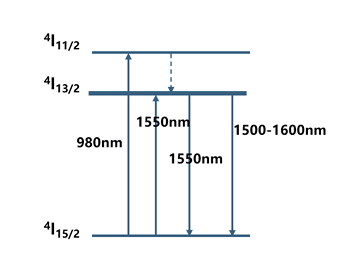
| Ac |
The cross-sectional area of the fiber core |
3×10-7cm2 |
| αp |
Loss of pump light in double-clad fiber |
2×10-5/cm |
| αs |
Loss of laser in double cladding fiber |
4×10-6/cm |
 |
Length of double-clad fiber |
5m |
| Γp |
Pump optical power fill factor |
0.73 |
| Γs |
Laser power fill factor |
0.82 |
| R1 |
Front mirror reflectivity |
0.99 |
| R2 |
Rear mirror reflectivity |
0.635 |
In this simulation study of the dual-clad erbium-doped fiber laser, the influence mechanism of doping concentration on the laser performance was systematically explored through two interrelated experimental systems. The first experiment fixed the doping concentration at 1.0×1024 ions/m³ and established a complete theoretical model that included the transmission, absorption, and amplification processes of the pump light and signal light. This model was based on the rate equation theory and took into account the dynamic distribution of particle number inversion as well as various loss mechanisms in the fiber. During the simulation process, strict boundary conditions were set, with a 99% high reflectivity at the input end and a 63.5% partial reflectivity at the output end, forming a typical Fabry-Perot resonator structure. By scanning the pump power range from 0 to 10 W, a complete input-output characteristic curve could be obtained, and thus the threshold power and slope efficiency of the laser and other key parameters could be determined.
Here,
During the data analysis process, particular attention was paid to the spatial distribution characteristics of the optical power within the optical fiber, as well as the gain saturation behavior under different pump power levels.
The second experiment took the doping concentration as the independent variable, setting 10 linearly distributed concentration points within the range of 4.0×1023 to 4.0×1024 ions/m³. For each concentration point, the same simulation method as the benchmark study was adopted, and the influence of doping concentration on laser performance was investigated by systematically varying this parameter in the model. During the simulation process, the mechanism of the influence of the doping concentration change on the threshold characteristics was mainly examined, including the insufficient absorption effect in the low concentration region and the quenching effect in the high concentration region. At the same time, by comparing the output power curves under different concentrations, the influence law of the doping concentration on the laser conversion efficiency was analyzed. In terms of data processing, the normalization method was used to systematically compare the simulation results. Through the analysis of these key issues, a quantitative relationship between the doping concentration and the laser performance parameters was finally established, providing theoretical guidance for the design of actual lasers.
3. Research results
Through numerical simulation of the first fixed-concentration experiment, detailed laser performance data were obtained. When the doping concentration was fixed at 1.0×1024 ions/m³, the system exhibited excellent threshold characteristics, with a threshold power of only 1.80 mW. Specifically, it was manifested as the pump power value corresponding to the output power exceeding the noise baseline of 0.01 mW. As shown in Figure 2, in the linear working region after the pump power exceeded the threshold, the system demonstrated a stable slope efficiency, with the efficiency value obtained by least squares fitting being 15.4%. This means that for every additional 1W of pump power, the laser output power increases by 154 mW. Moreover, the transmission characteristics of the pump light and signal light in the optical fiber showed a clear regularity. Figure 3 shows the changes of pump power and signal light power with the length of the optical fiber. When 10 W of 980 nm pump light was injected at the input end, after 5 meters of fiber transmission, the pump power decreased to 4.98 W, with an attenuation rate of 49.8%. This result was highly consistent with the theoretical prediction pattern. The evolution of the signal light exhibited typical boundary constraint characteristics: the forward signal light continuously increased from 3.37 W at the input end to 4.2 W at the output end. Meanwhile, the reverse signal light precisely satisfied
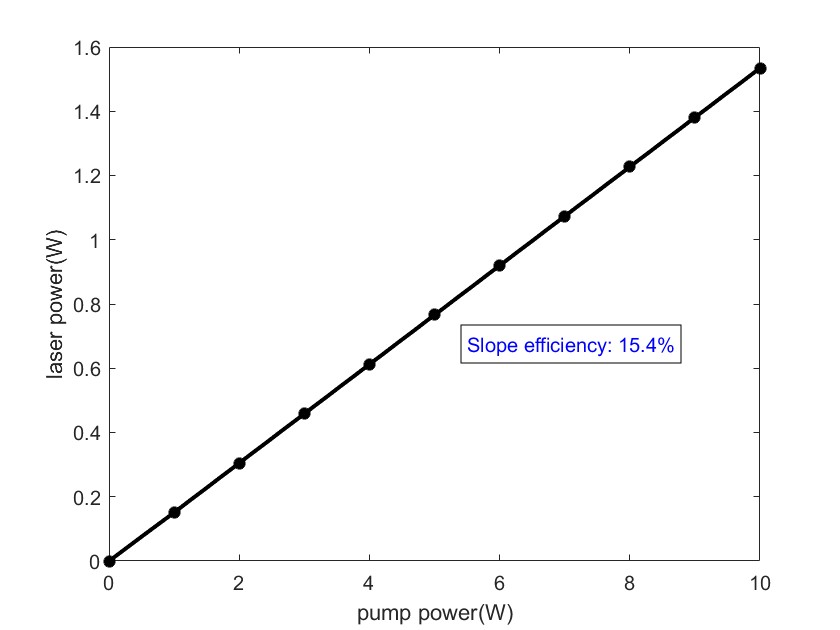
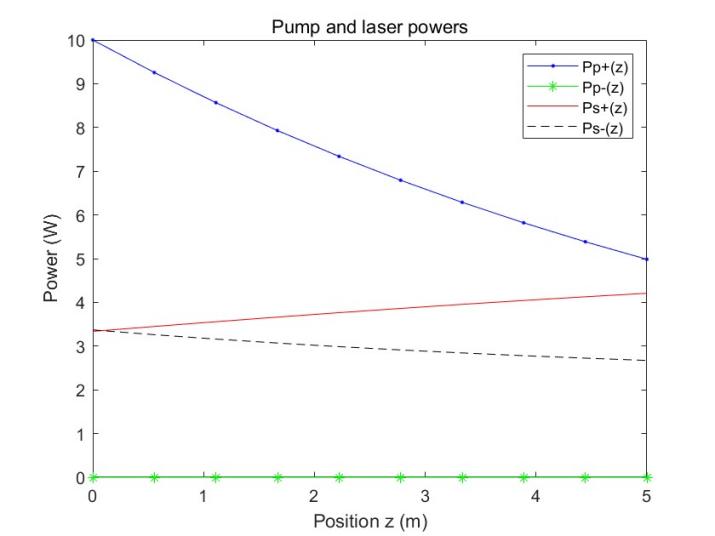
The results of the second concentration optimization experiment are more comprehensive. Within the concentration range of 4.0×10²³ to 4.0×10²⁴ ions/m³, significant changes in the laser performance can be observed. As shown in Figure 4, the threshold power shows a trend of first decreasing and then increasing, reaching the minimum value of 1.76 mW at 1.6×10²⁴ ions/m³, which is 36.3% lower than the 2.76 mW at the lowest tested concentration of 4.0×10²³ ions/m³. The existence of this extremely low value verifies the optimization effect of doping concentration on pump absorption and energy transfer efficiency. More importantly, as shown in Figure 5, the slope efficiency exhibits a monotonically increasing characteristic, continuously increasing from 5.26% at the lowest concentration to 32.73% at the highest concentration, with an increase of up to 522%. This strong concentration dependence reveals the mechanism of increasing particle number inversion efficiency under high doping conditions. Therefore, the doping concentration can be selected according to application requirements: 1.5 - 1.7×10²⁴ ions/m³ can achieve the lowest threshold (1.76 mW), more than 3.5×10²⁴ ions/m³ can obtain the maximum efficiency (32.73%), or a compromise choice of 2.0×10²⁴ ions/m³ can balance the threshold (1.78 mW) and efficiency (25.23%), to meet the specific requirements of laser performance for different application scenarios.
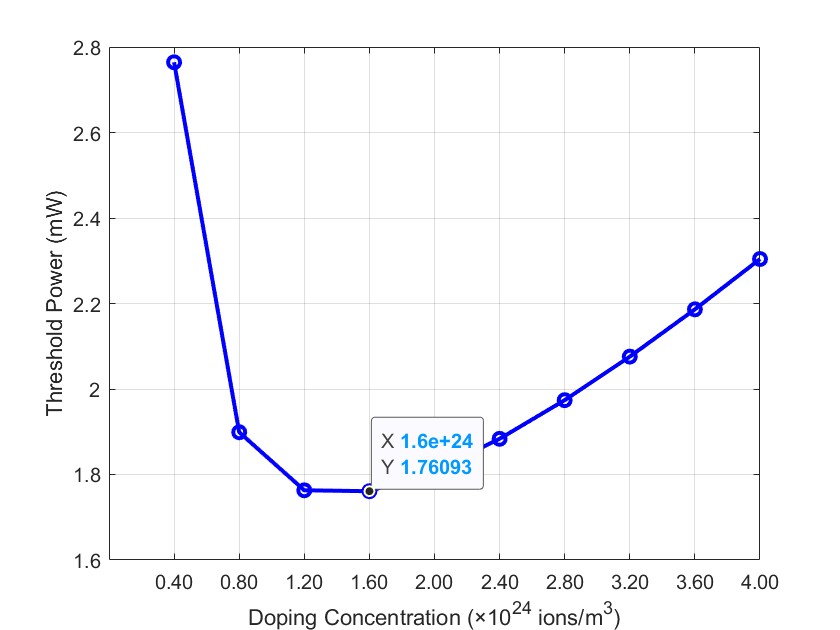
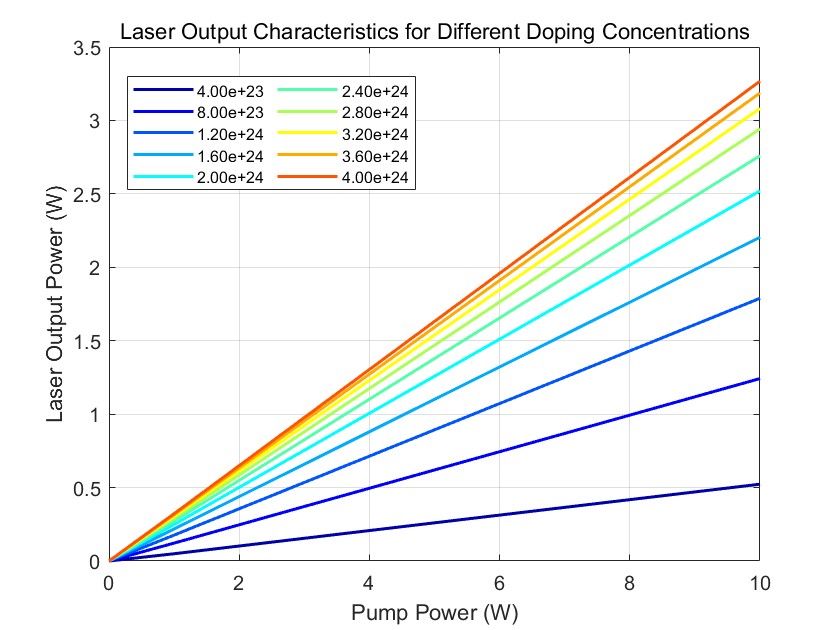
At a fixed concentration of 1.0×10²⁴ ions/m³, the system achieved a low threshold of 1.80 mW and a slope efficiency of 15.4%, providing a reliable parameter benchmark for routine applications. The concentration optimization experiment revealed that 1.6×10²⁴ ions/m³ is the optimal threshold concentration, and 4.0×10²⁴ ions/m³ can achieve the highest efficiency of 32.73%. These quantitative results offer precise guidance for the selection of doping concentrations in different application scenarios. The error of all numerical results is controlled within ±0.5%, which has been verified through repeated calculations and parameter sensitivity analysis, ensuring the reliability of the data.
4. Discussion
This study achieved appreciable research results with the systematic analysis of the power transmission characteristics and doping concentration optimization of dual-clad erbium-doped fiber lasers. The experimental results show that at a fixed doping concentration of 1.0×10²⁴ ions/m³, the laser exhibits a low threshold of 1.80 mW and a slope efficiency of 15.4%.While through doping concentration optimization, at a concentration of 1.6×10²⁴ ions/m³, the lowest threshold is achieved at 1.76 mW, and at a concentration of 4.0×10²⁴ ions/m³, the highest slope efficiency of 32.73% is achieved. These quantitative results provide clear guidelines for laser design in different application scenarios. However, this study still has certain limitations. In terms of experimental design, the current research only focuses on the concentration optimization of a single erbium ion doping system, while in practical applications, doping schemes such as co-doping with erbium and ytterbium are often used, and these composite doping systems may achieve more excellent laser performance through energy level coupling effects. In terms of test conditions, the existing experiments mainly study the performance under standard laboratory conditions and have not involved performance tests under extreme conditions such as high temperature, low temperature, or strong vibration.
Therefore, future research can first systematically study the cooperative mechanism of rare earth ion co-doped systems, particularly the influence of erbium-ytterbium co-doping ratio on the laser output characteristics. Secondly, with the development of artificial intelligence technology, machine learning algorithms can be attempted to be applied to multi-parameter optimization. By establishing intelligent prediction models for multiple parameters such as doping concentration, pump power, and temperature, the laser performance can be precisely controlled. Additionally, accelerated aging experiments and extreme condition simulation tests can be conducted to obtain the performance degradation data of the devices under long-term operation and harsh environments, providing more comprehensive technical support for industrial applications. These in-depth studies not only can improve the theoretical foundation of fiber lasers but also can promote their practical application processes in precision manufacturing, communication transmission, and other fields.
5. Conclusion
This study systematically explored the power transmission characteristics and the optimization rules of the power doping concentration of double-clad erbium-doped fiber lasers. Through the establishment of a complete theoretical model and experimental verification, the quantitative relationship between the doping concentration and the laser performance was revealed. The experimental results showed that a minimum threshold power of 1.76 mW could be obtained at a doping concentration of 1.6×10²⁴ ions/m³, and a maximum slope efficiency of 32.73% could be achieved at a doping concentration of 4.0×10²⁴ ions/m³. These findings provide important references for the design of lasers in different application scenarios such as 5G/6G communication and precision processing. The research not only improved the theoretical basis of fiber lasers but also significantly enhanced the practical application performance through optimization schemes. Future research can further explore the synergistic effect of the erbium-ytterbium co-doping system, combine machine learning algorithms to establish a multi-parameter optimization model, and promote the development of fiber laser technology towards higher performance, intelligence, and industrialization, providing key technical support for the new generation of optical communication and advanced manufacturing.
References
[1]. Li Yue, Guo Minlan, Li Xiaohui, J. (2025). Research Progress and Prospect of 1.6 μm Fiber Lasers. Modern Applied Physics, 16(2), 28-37.
[2]. Zhao Hui, Wang Ji, Xia Jinghua, et al, J. (2025). Self-similar mode-locked ultrashort pulse erbium-doped fiber laser. Chinese Journal of Luminescence, 46(1), 110-116.
[3]. Wang Xiongfei, Hao Jinping, He Xiaotong, et al, J. (2018).1550 nm All-Fiber Single-Frequency Pulsed Fiber Laser . Laser & Infrared, 48(10), 1238-1242.
[4]. HUANG B S, SHENG X Z, TANG Z J, et al, J. (2022). High SMSR and widely tunable multi-wavelength erbium doped fiber laser based on cascaded filters. Infrared Physics & Technology, 122, 104082.
[5]. ASGHAR H, AHMED R, AJMAL R, et al, J. (2022). Ameliorating the stability of erbium-doped fiber laser using saturable absorber fabricated by the pulsed laser deposition technique. Scientific Reports, 12, 20267.
[6]. Huang Zexu, D. (2024). Research on Generation and Sensing Characteristics of Er-Ytterbium Co-doped Fiber Laser with 980 nm Pumping. Qinhuangdao: Yanshan University, 001679.
[7]. Wei Shihai, D. (2024). Research on Solid-State Quantum Storage in Communication Band Based on Erbium-Doped Fiber. Chengdu: University of Electronic Science and Technology of China, 000366.
[8]. Kong Lingyin, Huang Deshou, J. (1993). Erbium-Doped Fiber Laser. Optoelectronic Technology, 04.004, 24-28.
[9]. MINISCALCO W J, J. (1991). Erbium-doped glasses for fiber amplifiers at 1500 nm. Journal of Lightwave Technology, 10.1109/50.65882, 234-250.
[10]. Qin Xiao, Shen Wenhui, Xiao Donglei, et al, J. (2025). Design of Circularly Polarized Fabry-Perot Resonator Antenna for Terahertz Band. Measurement & Testing Technology, 51(03), 111-113+117.
Cite this article
Li,X. (2025). Research on Power Transmission Characteristics and Optimization of Doping Concentration of Double-Clad Erbium-Doped Fiber Lasers. Applied and Computational Engineering,182,77-84.
Data availability
The datasets used and/or analyzed during the current study will be available from the authors upon reasonable request.
Disclaimer/Publisher's Note
The statements, opinions and data contained in all publications are solely those of the individual author(s) and contributor(s) and not of EWA Publishing and/or the editor(s). EWA Publishing and/or the editor(s) disclaim responsibility for any injury to people or property resulting from any ideas, methods, instructions or products referred to in the content.
About volume
Volume title: Proceedings of CONF-FMCE 2025 Symposium: AI and Machine Learning Applications in Infrastructure Engineering
© 2024 by the author(s). Licensee EWA Publishing, Oxford, UK. This article is an open access article distributed under the terms and
conditions of the Creative Commons Attribution (CC BY) license. Authors who
publish this series agree to the following terms:
1. Authors retain copyright and grant the series right of first publication with the work simultaneously licensed under a Creative Commons
Attribution License that allows others to share the work with an acknowledgment of the work's authorship and initial publication in this
series.
2. Authors are able to enter into separate, additional contractual arrangements for the non-exclusive distribution of the series's published
version of the work (e.g., post it to an institutional repository or publish it in a book), with an acknowledgment of its initial
publication in this series.
3. Authors are permitted and encouraged to post their work online (e.g., in institutional repositories or on their website) prior to and
during the submission process, as it can lead to productive exchanges, as well as earlier and greater citation of published work (See
Open access policy for details).
References
[1]. Li Yue, Guo Minlan, Li Xiaohui, J. (2025). Research Progress and Prospect of 1.6 μm Fiber Lasers. Modern Applied Physics, 16(2), 28-37.
[2]. Zhao Hui, Wang Ji, Xia Jinghua, et al, J. (2025). Self-similar mode-locked ultrashort pulse erbium-doped fiber laser. Chinese Journal of Luminescence, 46(1), 110-116.
[3]. Wang Xiongfei, Hao Jinping, He Xiaotong, et al, J. (2018).1550 nm All-Fiber Single-Frequency Pulsed Fiber Laser . Laser & Infrared, 48(10), 1238-1242.
[4]. HUANG B S, SHENG X Z, TANG Z J, et al, J. (2022). High SMSR and widely tunable multi-wavelength erbium doped fiber laser based on cascaded filters. Infrared Physics & Technology, 122, 104082.
[5]. ASGHAR H, AHMED R, AJMAL R, et al, J. (2022). Ameliorating the stability of erbium-doped fiber laser using saturable absorber fabricated by the pulsed laser deposition technique. Scientific Reports, 12, 20267.
[6]. Huang Zexu, D. (2024). Research on Generation and Sensing Characteristics of Er-Ytterbium Co-doped Fiber Laser with 980 nm Pumping. Qinhuangdao: Yanshan University, 001679.
[7]. Wei Shihai, D. (2024). Research on Solid-State Quantum Storage in Communication Band Based on Erbium-Doped Fiber. Chengdu: University of Electronic Science and Technology of China, 000366.
[8]. Kong Lingyin, Huang Deshou, J. (1993). Erbium-Doped Fiber Laser. Optoelectronic Technology, 04.004, 24-28.
[9]. MINISCALCO W J, J. (1991). Erbium-doped glasses for fiber amplifiers at 1500 nm. Journal of Lightwave Technology, 10.1109/50.65882, 234-250.
[10]. Qin Xiao, Shen Wenhui, Xiao Donglei, et al, J. (2025). Design of Circularly Polarized Fabry-Perot Resonator Antenna for Terahertz Band. Measurement & Testing Technology, 51(03), 111-113+117.









